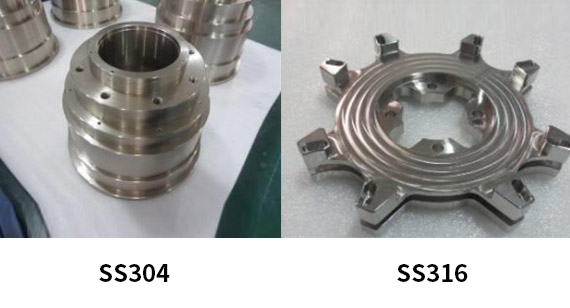15 years one-stop China custom CNC machining parts factory

Hey there I’m VMT Sam!
With 25 years of CNC machining experience we are committed to helping clients overcome 10000 complex part-processing challenges all to contribute to a better life through intelligent manufacturing. Contact us now
 116 |
Published by VMT at Aug 06 2021
116 |
Published by VMT at Aug 06 2021
Stainless steel is a kind of steel that is not easy to rust. Some stainless steels have both rust resistance and acid resistance (corrosion resistance). Commonly used stainless steel machining material models are indicated by number symbols. There are 200 series, 300 series and 400 series. They are American representation methods, such as 201, 202, 302, 303, 304, 316, 410, 420, 430, etc.
The types of stainless steel machining materials in China are represented by element symbols and numbers, such as 1Cr18Ni9, 0Cr18Ni9, 00Cr18Ni9, 1Cr17, 3Cr13, 1Cr17Mn6Ni5N, etc. The numbers indicate the corresponding element content. There are many types of stainless steel machining parts and materials, so we will not list them one by one. Today we will take you to understand the difference between stainless steel 304 and 316.
What is 304 stainless steel?
Stainless steel 304 is a commonly used material and is widely used in equipment and parts that require good overall performance (corrosion resistance and formability).
304 stainless steel machined parts materials are stainless steel grades produced in accordance with American ASTM standards. The density is 7.93 g/cm3, which is also called 18/8 stainless steel in the industry. With a high temperature resistance of 800℃, it is widely used in industrial and furniture decoration industries, as well as food and medical industries.

Characteristics of 304 stainless steel machined parts materials
1. Mechanical properties of stainless steel 304: strength, hardness, plasticity, fatigue, impact toughness;
2. Chemical properties: corrosion resistance, high temperature oxidation resistance;
3. Physical properties: density, melting point, thermal expansion, magnetism, conductivity;
4. Process performance: cutting performance, forgeability, castability, weldability;
5. Good processing performance and high toughness;
6. High temperature resistance 800℃;
7. Ni content is greater than 8%, Cr content is greater than 18%;
8. But the weldability is poor, usually not used as a welding material.
Application of 304 stainless steel machining parts materials
304 stainless steel machining materials are suitable for decoration and decoration fields (stainless steel anti-theft windows, stainless steel stair railings, etc.), auto parts (wipers, mufflers, molded products), medical equipment, building materials, chemicals, food industries, agriculture, ship parts, etc. However, in corrosive industries or marine environments, 316 stainless steel machining materials are used.
What is 316 stainless steel?
316 stainless steel machining material is hollow long round steel. 316 stainless steel has better corrosion resistance than 304 stainless steel. It is widely used in industrial pipelines and mechanical structural parts such as petroleum, chemical, medical, food, light industry, and mechanical instruments. In addition, under the same bending and torsion strength, the weight is lighter, so it is also widely used in the manufacture of mechanical parts and engineering structures.
Characteristics of 316 stainless steel machining materials
1.316 stainless steel machining material has high strength and can be molded into various shapes without cracking;
2. It has high resistance to corrosion and pitting corrosion; it can be used to make materials exposed to chemicals and acids;
3. Has good shape and welding performance;
4. The modulus of elasticity is about 193GPa;
5.Melting point range 13710C-13990C;
6. The minimum tensile strength is 515MPa;
7. The density is 7.98g/cm3.
Application of 316 stainless steel machining materials
316 stainless steel machining materials are widely used in chemistry, construction, bridges, aerospace, mechanical hardware, medical treatment, decoration, medical fitness products, furniture, tableware manufacturing, liquid transportation, automobile manufacturing, water supply, solar energy, machinery manufacturing, nuclear power, and construction Decoration, rail transit, sanitary ware, metal products, containers and other industries.
Summarize
Both 304 stainless steel and 316 stainless steel are code names for stainless steel. Essentially, they are no different. They are all stainless steel machining materials, but they are subdivided into different types. The performance of 316 stainless steel is better than that of 304 stainless steel. 316 stainless steel is added with metallic molybdenum on the basis of 304. This element can further strengthen the molecular structure of stainless steel, making it more wear-resistant and oxidation-resistant, and its corrosion resistance is also greatly improved. Because 316 stainless steel is better than 304 stainless steel in terms of corrosion resistance, the price of 316 stainless steel machining materials is also more expensive.
Ready To Start Your Next Project?
Get Instant Quote

Request a Free Quote
Send us a message if you have any questions or request a quote. We will get back to you ASAP!